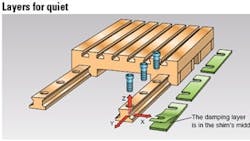Anti-vibration shims
There are two main sources of vibration in a machine: transmission of motive force to the machine, and its actual activity — whether cutting, stamping, or otherwise. Vibrations are magnified when mechanical assemblies, built of parts manufactured to tolerances that accumulate, introduce play and backlash.
Shims make connections tight to reduce play and resulting vibration. Laminated shims, manufactured from metal or composites that peel off in strips a few hundredths of a millimeter thick make for well-coupled monolithic gap compensation.
Q&A
How else can designers mitigate vibration?
Installing anti-vibratory feet decouples machines from the floor, to minimize environmental transmission of vibration. Capping machines with several layers of alternating hard and soft materials is helpful in reducing noise. Finally, specifying power transmission components with tighter tolerances and control systems that adjust for vibration are other options, though these many be more costly.
One shimming option is ground shims: With these, a technician determines how much compensation is needed and grinds spacers with a machine — a time-consuming process. Another option is solid shims: A technician inserts stacks of thin plates into areas with play — a setup that can collect grease and dust.
How do I specify shims?
Determine what hardness and strength the application requires as quantified by Vickers values. Some shims are stronger than others: Pressure resistance is 99,563 psi for stainless, 120,898 for steel, and 135,121 psi for laminated steel shims. Soft (1010) and stainless (AISI 302, 304, 316) steel damp best.
Where do shims help?
Loud environments may not meet safety standards because they compromise both operator hearing and concentration. Shims address the problem. For example, on a blowing machine producing 30,000 bottles an hour, laminated shims allow operators to dispense with bulky hearing protection and communicate on the shop floor without radio headsets.
The protection of equipment is another benefit of reducing vibration. Minimizing vibration's conversion into heat energy prolongs machinery life and extends the consistency of performance tolerances.
This month's tips provided by Daniel Gastel of Lameco USA, Santa Monica. For more information, call (310) 496-4221 or visit lamecogroup.com.
Layers for quiet
Laminated shims are made of thin sheets that can be peeled off to adjust thickness. Some varieties are embedded with electronic identifier chips that can report design specifications to handheld readers.
Material proof
Shims designed for motion damping can absorb about 50% of vibration amplitude and reduce settling time by 50 to 55%.
